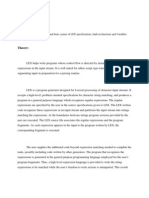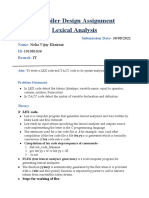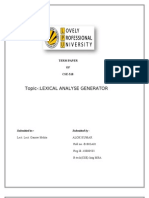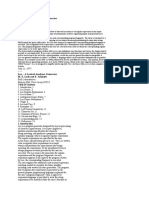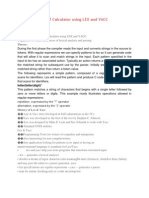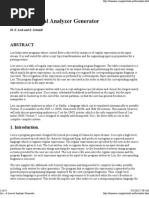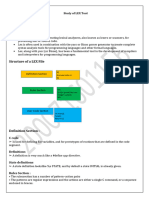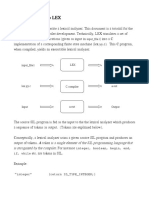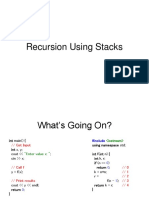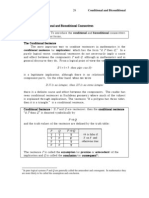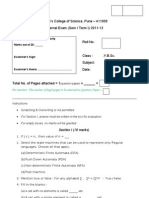Compiler Design Manual
Compiler Design Manual
Uploaded by
ZainaZakiCopyright:
Available Formats
Compiler Design Manual
Compiler Design Manual
Uploaded by
ZainaZakiOriginal Title
Copyright
Available Formats
Share this document
Did you find this document useful?
Is this content inappropriate?
Copyright:
Available Formats
Compiler Design Manual
Compiler Design Manual
Uploaded by
ZainaZakiCopyright:
Available Formats
Design of Language Processor
Practical – 1
Introduction to LEX
Prepared By:- Bijal U. Gadhia SVBIT
Design of Language Processor
The Lex
A lexical analyzer takes input streams and divides into tokens. This division into units is
known as lexical analysis. Lex takes set of rules for valid tokens and produce C program
which we call lexical analyzer or lexer that can identify these tokens.
Lex is a lexical analyzer generator-a tool for programming that recognizes lexical
patterns in the input with the help of Lex specifications.
Lex is generally used in the manner as shown below.
First, a
specification
of a lexical
analyzer is
prepared by
creating a
program lex.l
in the Lex
language. Then, the lex.l is run through the Lex compiler to produce a c program
lex.yy.c. This program consists of a tabular representation of a transition diagram
constructed from the regular expression of lex.l, together with a standard routine that uses
the table to recognize lexemes.
The action associated with regular expression in lex.l is pieces of C code and are carried
over directly to lex.yy.c.
Finally lex.yy.c is run through the C compiler to produce an object program a.out, which
is the lexical analyzer that transforms an input stream into a sequence of tokens.
Structure of Lex Program
Declarations
%%
Rules Section
%%
User Code(Auxiliary) Section
Definition Section
It contains different user defined Lex options used by the lexer. It also creates an
environment for the execution of the Lex program.
The definition section creates an environment for the lexer, which is a C code. This area
of the Lex specification is separated by “ %{ “ , and it contains C statements, such as
Prepared By:- Bijal U. Gadhia SVBIT
Design of Language Processor
global declarations, commands, including library files and other declarations, which will
be copied to the lexical analyzer(lex.yy.c) when it passed through the Lex tool.
The definition section provides an environment for the Lex tool to convert the Lex
specifications correctly and efficiently to a lexical analyzer. This section mainly contains
declarations of simple name definitions to simplify the scanner specifications and
declarations of start condition. The statement in this section will help the Lex rules to run
efficiently.
Example:
%{
#include "calc.h"
#include <stdio.h>
#include <stdlib.h>
char name[10];
%}
/* Regular expressions */
/* ------------------- */
white [\t\n ]+
letter [A-Za-z]
digit [0-9]
identifier {letter}(_|{letter}|{digit10})*
Rule Section
It contains the patterns and actions that specify the lex specifications. A pattern is in the
form of a regular expression to match the largest possible string.
Once the pattern is matched, the corresponding action part is invoked. The action part
contains normal C language statements.
They are enclosed within braces ( “{“ and “}”), if there is more than one statement then
make these component statements into single block of statements.
Example
%%
{LETTER}({LETTER}| {DIGIT})* {
printf(“\n It is a Identifier: %s \n”, yytext);
}
%%
Prepared By:- Bijal U. Gadhia SVBIT
Design of Language Processor
Always use braces to make the code clear, if the action has more than one statement or
more than one line large.
The lexer always tries to match the largest possible string, but when there are two
possible rules that match the same length, the lexer uses the first rule in the Lex
specification to invoke its corresponding action.
User defined section
This section contains any valid C code. Lex copies the contents of this section into
generated lexical analyzer as it is.
Example
/* ……………User define Function………………..*/
void display(int a)
{
………
………..
}
main()
{
yylex();
}
Lex itself does not produce an executable program; instead, it translates the Lex
specifications into a file containing a C subroutine called yylex().
All the rules in the rule section will automatically be converted into C statements by the
Lex tool and will be put under the function name of yylex().
Whenever, we call the function yylex, C statements corresponding to the rules will be
executed.
That is we called the function yylex() in main function, even though we have not defined
it anywhere in the program.
Compiling and executing the Lex program
%{
%}
%%
%%
main()
{
yylex();
}
Prepared By:- Bijal U. Gadhia SVBIT
Design of Language Processor
Let above program be in file called practical.l. To create or generate a lexical analyzer we must
enter the following command
$ lex practical.l
When, the above command is executed, Lex translates the Lex specification into a C source file
called lex.yy.c, which is a lexical analyzer. Any lexical analyzer can be compiled using the
following command
$ cc lex.yy.c –ll
This will compile the lexical analyzer, lex.yy.c, using any C compiler by linking it with Lex
library using the extension –ll. After compilation, the output, by default, will write to “a.out” file.
The resulting program is executed using the following command
$ ./a.out
or
$ ./a.out < filename
Lex variables
yyin Of the type FILE*. This points to the current file being parsed by the lexer.
yyout Of the type FILE*. This points to the location where the output of the lexer
will be written. By default, both yyin and yyout point to standard input and
output.
yytext The text of the matched pattern is stored in this variable (char*).
yyleng Gives the length of the matched pattern.
yylinen Provides current line number information
o
Yytext and yyleng
When the generated scanner is run, it analyzes its input looking for strings which match
any of its patterns. If it finds more than one match, it takes the one matching the most
text.
If it finds two or more matches of the same length, the rule listed first in the flex input file
is chosen.
Once the match is determined which satisfying one of the regular expression or rule, the
text corresponding to the match (called the token) is made available in the global
character pointer yytext, and its length in the global integer yyleng.
The action corresponding to the matched pattern is then executed and then the remaining
input is scanned for another match.
If no match is found, then the default rule is executed: the next character in the input is
considered matched and copied to the standard output.
yytext can be defined in two different ways: either as a character pointer or as a character
array.
Prepared By:- Bijal U. Gadhia SVBIT
Design of Language Processor
We can control which definition lex uses by including one of the special directives `
%pointer' or `%array' in the first (definitions) section of lex input.
The default is `%pointer' and the advantage of using `%pointer' is substantially faster
scanning and no buffer overflow when matching very large tokens (unless run out of
dynamic memory).
The disadvantage is that `input()' function destroys the present contents of yytext, which
can be a considerable porting headache when moving between different lex versions.
The advantage of `%array' is that we can then modify yytext to your heart's content, and
calls to `unput()' do not destroy yytext.
Existing lex programs sometimes access yytext externally using declarations of the form:
extern char yytext[];
This definition is erroneous when used with `%pointer', but correct for `%array'.
`%array' defines yytext to be an array of YYLMAX characters, which defaults to a fairly
large value. We can change the size by simply
#define YYLMAX <constant number>.
As mentioned above, with `%pointer' yytext grows dynamically to accommodate large
tokens. While this means your `%pointer' scanner can accommodate very large tokens
(such as matching entire blocks of comments), bear in mind that each time the scanner
must resize yytext it also must rescan the entire token from the beginning, so matching
such tokens can prove slow.
yytext presently does not dynamically grow if a call to `unput()' results in too much text
being pushed back; instead, a runtime error results.
Special Directives
There are number of special directives which can be included within an action. Directives, like
keywords in C, are those words whose meaning has been already predefined in Lex tool. Mainly
we have three directives in Lex.
1. ECHO:- It copies yytext to the scanner’s output. That is, whatever token we have recently
found will be copied to the output.
2. BEGIN:- The directive BEGIN followed by the name of the start symbol, places the
scanner in the corresponding rules. Lex activates the rules using the directive BEGIN and
a start condition.
3. REJECT:- It directs the scanner to proceed on to the "scanned best" rule which matched
the input (or a prefix of the input). That is, as soon as REJECT statement is executed in
the action part, the last letter, will be treated (or prefixed) from the recently matched
token and will go ahead with the prefixed input for next best rule.
Example
%{
%}
%%
Prepared By:- Bijal U. Gadhia SVBIT
Design of Language Processor
[a-z]+ {
printf(“\n String contains only lower case letters= ”);
ECHO;
}
[a-zA-Z]+ {
printf(“\n String contains both lower & upper case letters= ”);
ECHO; REJECT;
}
%%
main()
{
yylex();
}
$ ./a.out
asDF
Start Conditions
Start conditions are declared in the definition section of the Lex program using
unintended lines beginning with either %s or %x, followed by a list of names called start
symbols.
A start condition rule is activated using the directives BEGIN. Until the next BEGIN
action is executed, rules with the given start conditions will be active and those with other
conditions will be inactive.
If a start condition is declared with %s, then it is called an inclusive start condition. If the
start condition is declared as inclusive, then all rules without any start condition and rules
with corresponding start condition will be active.
If start condition is declared with %x, then it is called an exclusive start condition. If start
condition is declared as exclusive, then an only rule that is/are qualified with the start
condition will be active.
Example
%{
%}
%s SM SMBG
%%
# BEGIN(SM);
Prepared By:- Bijal U. Gadhia SVBIT
Design of Language Processor
## BEGIN(SMBG);
[0-9]+ {
printf(“\n It’s a Digit ”);
}
<SMBG>[A-Z]+ {
printf(“\n String contains upper case letters ”);
}
<SM>. {
printf(“\n Exiting from # start condition ”);
BEGIN(INITIAL);
}
<SM, SMBG>[a-z]+ {
printf(“\n String contains lower case letters ”);
}
<SMBG>.+ {
printf(“\n Exiting from ## start condition ”);
}
.+ {
printf(“\n No action to execute ”);
}
%%
main()
{
printf(“\n Enter # when u r executing digits and small case letter strings ”);
printf(“\n Enter ## when u r executing only upper and small case letter strings ”);
yylex();
}
Prepared By:- Bijal U. Gadhia SVBIT
Design of Language Processor
2. This contains no patterns and no actions. Thus, any string matches and default action, i.e
printing takes place.
%{
%}
%%
%%
main()
{
yylex();
return 0;
}
Prepared By:- Bijal U. Gadhia SVBIT
Design of Language Processor
3. LEX program to show the message when enter key is pressed
%{
%}
%%
[\n] {
printf(“\n Hi…..Good….Morning\n”);
}
%%
main()
{
yylex();
return 0;
}
Prepared By:- Bijal U. Gadhia SVBIT
Design of Language Processor
4. LEX program to print the name of user with message when enter key is pressed
%{
#include<stdio.h>
char name[20];
%}
%%
[\n] {
printf(“\n Hi…..Good….Morning\n”);
}
%%
main()
{
char ch;
do
{
printf(“\n Enter your name\n”);
scanf(“%s”, &name);
yylex();
printf(“\n Press any key to continue(Y/y):”);
scanf(“%c”, &ch);
}while((ch= =’Y’) || (ch= =’y’))
}
Prepared By:- Bijal U. Gadhia SVBIT
Design of Language Processor
5. LEX program to check whether the string is in smallcase letter,uppercase letter or
contains mixed letter
%{
%}
%%
[a-z]+ {
printf(“\n String contains only lower case letters ”);
}
[A-Z]+ {
printf(“\n String contains only upper case letters ”);
}
[a-zA-Z]+ {
printf(“\n String contains both lower & upper case letters”);
}
%%
main()
{
yylex();
}
Prepared By:- Bijal U. Gadhia SVBIT
Design of Language Processor
6. LEX program to print the name of the user with message when the enter key is pressed
using the function
%{
void display(char*)
%}
%%
[\n] {
char name[20];
printf(“\n Enter your name\n”);
scanf(“%s”, &name);
display(&name[20]);
return;
}
%%
void display(char* in)
{
printf(“\n Hi…..Good….Morning\n”);
}
main()
{
printf(“\n Press enter key…..\n”);
yylex();
}
Prepared By:- Bijal U. Gadhia SVBIT
Design of Language Processor
7. LEX program to check whether the given word is vowel or not using the function.
%{
void display(int)
%}
%%
[a|e|i|o|u][a-zA-Z]+ {
int flag=1;
display(flag);
return;
}
.+ {
int flag=0;
display(flag);
return;
}
void display(int flag)
{
if(flag = =0)
printf(“\n The given word is vowel\n”);
else
printf(“\n The given word is not vowel\n”);
}
main()
{
printf(“\n Enter the word\n”);
yylex();
}
Prepared By:- Bijal U. Gadhia SVBIT
Design of Language Processor
8. LEX program which demonstrate the use of yymore function
This function will output the yytext, when execution of the action part of any rule that invoked
yymore() ends.
Example
%{
%}
%%
[a-z]+ {
printf(“\n String contains only lower case letters= ”);
ECHO; printf(“ Beginning of the first yymore”);
yymore(); printf(“ End of the first yymore”);
[a-zA-Z]+ {
printf(“\n String contains both lower & upper case letters= ”);
ECHO; printf(“ Beginning of the second yymore”);
yymore(); printf(“ End of the second yymore”);
}
%%
main()
{
yylex();
}
Prepared By:- Bijal U. Gadhia SVBIT
Design of Language Processor
$ ./a.out
Good Morning
9. LEX program which demonstrate the use of yyless function
This function yyless(n) returns all characters, except the first n characters of the current tokens,
back to the input stream, where they will be re-scanned when the scanner looks for the next
match.
Example
%{
%}
%%
[a-z]+ {
printf(“\n The string is= ”);
ECHO;
yyless(2);
printf(“ The string after yyless= ”); ECHO;
}
[a-zA-Z]+ {
printf(“\n String contains both lower & upper case letters= ”);
ECHO;
}
%%
main()
{
yylex();
Prepared By:- Bijal U. Gadhia SVBIT
Design of Language Processor
$ ./a.out
Nice morning
10. LEX program which demonstrate the use of unput function
This function unput(a) puts or returns character a back into the input stream and it will be the
nect character to be scanned.
Example1
%{
%}
%%
“un” {
printf(“\n The unput char = ”);
ECHO;
}
[a-z]+ {
printf(“\n String contains only lower case letters= ”);
ECHO; unput(‘n’); unput(‘u’);
printf(“\n The string after unput= ”); ECHO;
}
[a-zA-Z]+ {
printf(“\n String contains both lower & upper case letters= ”);
ECHO;
}
%%
Prepared By:- Bijal U. Gadhia SVBIT
Design of Language Processor
main()
{
yylex();
}
$ ./a.out
good Day
Example2
%{
#define YYLMAX 10
%}
%array yytext
%%
“un” {
printf(“\n The unput char = ”);
ECHO;
}
[a-z]+ {
printf(“\n String contains only lower case letters= ”);
ECHO; unput(‘n’);
printf(“\n The string after first unput= ”); ECHO;
unput(‘u’);
printf(“\n The string after second unput= ”); ECHO;
}
[a-zA-Z]+ {
printf(“\n String contains both lower & upper case letters= ”);
ECHO;
}
%%
main()
{
yylex();
}
Prepared By:- Bijal U. Gadhia SVBIT
Design of Language Processor
$ ./a.out
good Day
11. LEX program which demonstrate the use of input function
This function reads the next character from the input stream. The read character will not be made
available to the scanner.
Example
%{
%}
%%
[a-zA-Z0-9]+ {
printf(“\n String contains mixed letters= ”);
ECHO;
}
“/*” {
printf(“\n The comment begins ”);
char c;
while(( c=input() )!= ‘*’);
if ((c=input()) = = ’/’)
printf(“\n The comment ends ”);
%%
main()
Prepared By:- Bijal U. Gadhia SVBIT
Design of Language Processor
{
yylex();
}
$ ./a.out
This program is written by /* Name */
12. LEX program to recognizes the keyword if, begin and identifier which is defined as any
string starts with letter and followed by letter or digit.
%{
#include<stdio.h>
%}
Letter[a-zA-Z]
Digit[0-9]
%%
begin {
printf(“\n It is a keyword:%s\n”,yytext);
}
if {
printf(“\n It is a keyword:%s\n”,yytext);
}
{Letter}({Letter} || {Digit})* {
printf(“\n It is a Identifier:%s\n”,yytext);
}
%%
main()
{
yylex();
}
Prepared By:- Bijal U. Gadhia SVBIT
Design of Language Processor
13. LEX program to recognizes the keyword if, begin and identifier which is defined as any
string starts with letter and followed by letter or digit and count the number of identifiers,
keywords and operators encountered in the input.
%{
Int k=0,op=0,id=0;
%}
Letter[a-zA-Z]
Digit[0-9]
%%
(begin|if|else|while|do|then) {
k++;
}
[+*-/<>=] {
op++;
}
(<=|>=|!=) {
op++;
}
[. ; \ .] ;
{Letter}({Letter} || {Digit})* {
id++;
}
%%
Prepared By:- Bijal U. Gadhia SVBIT
Design of Language Processor
main()
{
yylex();
printf(“\n Number od ID’s=%d\t, Keywords=%d\t, Operators=%d\t”, id,k,op);
}
14. Program using LEX to count the number of characters, words, spaces and lines in a
given input file.
%{
int ch=0, bl=0, ln=0, wr=0;
%}
%%
[\n] {ln++;wr++;}
[\t] {bl++;wr++;}
[" "] {bl++;wr++;}
[^\n\t] {ch++;}
%%
int main()
{
FILE *fp;
char file[10];
printf("Enter the filename: ");
scanf("%s", file);
yyin=fp;
yylex();
printf("Character=%d\nBlank=%d\nLines=%d\nWords=%d", ch, bl, ln, wr);
return 0;
}
Prepared By:- Bijal U. Gadhia SVBIT
Design of Language Processor
15. Program using LEX to recognize a valid arithmetic expression and to recognize the
identifiers and operators present. Print them separately.
%{
#include<stdio.h>
int a=0,s=0,m=0,d=0,ob=0,cb=0;
int flaga=0, flags=0, flagm=0, flagd=0;
%}
id [a-zA-Z]+
%%
{id} {printf("\n %s is an identifier\n",yytext);}
[+] {a++;flaga=1;}
[-] {s++;flags=1;}
[*] {m++;flagm=1;}
[/] {d++;flagd=1;}
[(] {ob++;}
[)] {cb++;}
%%
int main()
{
printf("Enter the expression\n");
yylex();
if(ob-cb==0)
{
printf("Valid expression\n");
}
Prepared By:- Bijal U. Gadhia SVBIT
Design of Language Processor
else
{
printf("Invalid expression");
}
printf("\nAdd=%d\nSub=%d\nMul=%d\nDiv=%d\n",a,s,m,d);
printf("Operators are: \n");
if(flaga)
printf("+\n");
if(flags)
printf("-\n");
if(flagm)
printf("*\n");
if(flagd)
printf("/\n");
return 0;
}
16. LEX program to check whether the parenthesis in the statement is missing or not
%{
int flag=0,ln=1;
%}
%%
“(“ {
flag++;
}
“)” {
flag--;
}
[\n] {
if(flag= =0)
printf(”\n the statement in the line %d has no parenthesis is missing\n”,ln);
else
printf(“\n Error…..in the line:%d”,ln);
if(flag < 0)
printf(”\n It has missed ( parenthesis or extra ) parenthesis \n”);
else if(flag > 0)
printf(”\n It has missed ) parenthesis or extra ( parenthesis \n”);
flag=0; ln++;
%%
Prepared By:- Bijal U. Gadhia SVBIT
Design of Language Processor
main()
{
Char filename[20];
printf(“\n Enter the file name:”\n);
scanf(“%s”, filename)
yyin=fopen(filename,”r+”);
yylex();
}
17. Lex program which replaces all the occurances of “rama” with “RAMA” and “sita”
with “SITA”. It demonstrate the use of string as a direct pattern in the specification file.
%{
%}
%%
“rama” {
Printf(“RAMA”);
}
“sita” {
Printf(“SITA”);
}
%%
main(int argc, char* argv[ ])
{
Extern FILE* yyin;
yyin = fopen(argv[1],”r”);
Prepared By:- Bijal U. Gadhia SVBIT
Design of Language Processor
yylex();
printf(“\n”);
return 0;
}
18. Lex program to count all occurrences of “ rama “ and “ sita “ in a given file.
%{
int count=0;
%}
%%
“rama” {
count++;
}
“sita” {
count++;
}
%%
main(int argc, char* argv[ ])
{
Extern FILE* yyin;
yyin = fopen(argv[1],”r”);
Prepared By:- Bijal U. Gadhia SVBIT
Design of Language Processor
yylex();
printf(“ No of occurrences = %d\n”, count);
return 0;
}
19.LEX program which removes all occurrences “ rama “ and “ sita “ in a given file
%{
int count=0;
%}
%%
“rama”
“sita”
. ECHO ;
%%
main( )
{
yylex( );
}
Prepared By:- Bijal U. Gadhia SVBIT
Design of Language Processor
20. Lex program, to count all instances of she and he, including the instances of he that are
included in she.
%{
int count=0;
%}
%%
she {
count++;
REJECT;
}
he {
count++;
}
.;
%%
Prepared By:- Bijal U. Gadhia SVBIT
Design of Language Processor
main(int argc, char* argv[ ])
{
Extern FILE* yyin;
yyin = fopen(argv[1],”r”);
yylex();
printf(“ No of occurrences of he including he in she = %d\n”, count);
return 0;
}
21. Lex program which counts number of words in a file other than the word “ incl”
%{
int nw=0;
%}
%%
incl nw;
REJECT;
[^ \t\n]+ nw++;
%%
main(int argc, char* argv[ ])
{
Extern FILE* yyin;
yyin = fopen(argv[1],”r”);
yylex();
printf(“ No of occurrences of other than words incl = %d\n”, nw);
Prepared By:- Bijal U. Gadhia SVBIT
Design of Language Processor
return 0;
}
22. Lex program which take string “abcd ” and print the following output
abcd
abc
ab
a
%{
%}
%%
a | ab | abc | abcd {
printf(“%s\n”, yytext);
REJECT;
}
%%
main(int argc, char* argv[ ])
{
Prepared By:- Bijal U. Gadhia SVBIT
Design of Language Processor
Extern FILE* yyin;
yyin = fopen(argv[1],”r”);
yylex();
return 0;
}
23. Lex program that changes all numbers to hexadecimal in input file while ignoring all
others.
%}
%}
Digit [0-9]
number {Digit}+
%%
{number} {
int n = atoi(yytext);
printf(“%x”, n);
}
%%
main(int argc, char* argv[ ])
{
Prepared By:- Bijal U. Gadhia SVBIT
Design of Language Processor
Extern FILE* yyin;
yyin = fopen(argv[1],”r”);
yylex();
return 0;
}
24. Lex program to recognize whether a given sentence is simple or compound
%{
int flag =0;
%}
%%
( [aA][nN][dD] ) {
flag=1;
}
“or “ {
flag =1;
}
“nevertheless” {
flag =1;
}
Prepared By:- Bijal U. Gadhia SVBIT
Design of Language Processor
“inspite” {
flag =1;
}
.;
%%
main()
{
printf(“\n enter the sentence \n”);
yylex();
if ( flag = =0 )
printf”\n Sentence is simple”);
else
printf(“\n Sentence is compound”);
}
25. LEX program to implement the positive closure of 10
%{
%}
Digit[0-9]
%%
Digit+ {
printf(“\n It is a positive closure\n”);
}
.+ {
printf(“\n It is not a positive closure\n”);
}
main()
{
yylex();
}
Prepared By:- Bijal U. Gadhia SVBIT
Design of Language Processor
26. LEX program that accept the language L = { a n-1 b n+m, where n > =1 and m> =0 }
%{
int check(int,char*);
%}
%%
[ab]* {
int leng=check(yyleng,yytext);
if(leng==1)
printf("\n accepted\n");
else
printf("\n not accepted\n");
}
%%
Prepared By:- Bijal U. Gadhia SVBIT
Design of Language Processor
main()
{
yylex();
}
int check(int leng,char*token)
{
int i, flag=0,ca=0,cb=0;
char ch;
for(i=1,ch=token[0]; ch=='a' && i<leng; i++)
{
ca++;
ch=token[i];
}
for(i=ca,ch=token[ca];ch=='b'&& i<leng; i++)
{
cb++;
ch=token[i];
}
if(((ca < cb) && (ca+cb)==leng))
flag=1;
return(flag);
}
27. LEX program that accept the language L = { 1 n-1 0 n, where n > =1 }
%{
int check(int,char*);
%}
%%
[ab]* {
int leng=check(yyleng,yytext);
if(leng==1)
printf("\n accepted\n");
else
printf("\n not accepted\n");
}
Prepared By:- Bijal U. Gadhia SVBIT
Design of Language Processor
%%
main()
{
yylex();
}
int check(int leng,char*token)
{
int i, flag=0,c0=0,c1=0;
char ch;
for(i=1,ch=token[0]; ch=='1' && i<leng; i++)
{
c1++;
ch=token[i];
}
for(i=c1;ch=='0'&& i<leng; i++)
{
C0++;
ch=token[i];
}
if(((c0 + 1 ) = = c1) && (c0 + c1) = =leng))
flag=1;
return(flag);
}
28. LEX program that implement the simple desktop calculator
%{
flaot op1=0,op2=0,ans=0;
char oper;
int f1=0,f2=0;
void eval();
%}
Digit [0-9]
Num {Digit}+
Op [+/\*-]
%%
Prepared By:- Bijal U. Gadhia SVBIT
Design of Language Processor
{Num} {
if (f1 = = 0)
{
Op1=atof(yytext);
f1=1;
}
else if (f2 = = -1)
{
Op2=atof(yytext);
f2=1;
}
if(( f1 = =1) && (f2= =1))
eval();
}
{Op} {
oper = (char)* yytext;
f2 = -1;
}
[\n] {
if(( f1 = =1) && (f2 = =1))
eval();
f1=0; f2=0;
}
%%
void eval()
{
f1=0; f2=0;
switch(oper)
{
case ‘+’:ans=op1 + op2;
break;
case ‘-’:ans=op1 - op2;
break;
case ‘*’:ans=op1 * op2;
break;
case ‘/’:ans=op1 / op2;
break;
default:
printf(“\n program is not supporting the %c”, oper);
break;
}
printf(“\n the answer is = %f”, ans);
}
Prepared By:- Bijal U. Gadhia SVBIT
Design of Language Processor
Prepared By:- Bijal U. Gadhia SVBIT
Design of Language Processor
Practical - 29
Introduction to Yacc
Introduction
Yacc provides a general tool for imposing structure on the input to a computer program.
The Yacc user prepares a specification of the input process; this includes rules describing the
input structure, code to be invoked when these rules are recognized, and a low-level routine to do
the basic input. Yacc then generates a function to control the input process. This function, called
a parser, calls the user-supplied low-level input routine (the lexical analyzer) to pick up the basic
items (called tokens) from the input stream. These tokens are organized according to the input
structure rules, called grammar rules; when one of these rules has been recognized, then user
Prepared By:- Bijal U. Gadhia SVBIT
Design of Language Processor
code supplied for this rule, an action, is invoked; actions have the ability to return values and
make use of the values of other actions.
The heart of the input specification is a collection of grammar rules. Each rule describes
an allowable structure and gives it a name. For example, one grammar rule might be
date : month_name day ',' year ;
Here, date, month_name, day, and year represent structures of interest in the input process;
presumably, month_name, day, and year are defined elsewhere. The comma ``,'' is enclosed in
single quotes; this implies that the comma is to appear literally in the input. The colon and
semicolon merely serve as punctuation in the rule, and have no significance in controlling the
input. Thus, with proper definitions, the input July 4, 1776 might be matched by the above rule.
An important part of the input process is carried out by the lexical analyzer. This user
routine reads the input stream, recognizing the lower level structures, and communicates these
tokens to the parser. For historical reasons, a structure recognized by the lexical analyzer is
called a terminal symbol, while the structure recognized by the parser is called a nonterminal
symbol. To avoid confusion, terminal symbols will usually be referred to as tokens.
There is considerable leeway in deciding whether to recognize structures using the lexical
analyzer or grammar rules. For example, the rules
month_name : 'J' 'a' 'n' ;
month_name : 'F' 'e' 'b' ;
……….
month_name : 'D' 'e' 'c' ;
might be used in the above example. The lexical analyzer would only need to recognize
individual letters, and month_name would be a nonterminal symbol. Such low-level rules tend to
waste time and space, and may complicate the specification beyond Yacc's ability to deal with it.
Usually, the lexical analyzer would recognize the month names, and return an indication that a
month_name was seen; in this case, month_name would be a token.
Literal characters such as ``,'' must also be passed through the lexical analyzer, and are also
considered tokens.
Specification files are very flexible. It is realively easy to add to the above example the rule
date : month '/' day '/' year ;
allowing
7 / 4 / 1776
as a synonym for
July 4, 1776
Prepared By:- Bijal U. Gadhia SVBIT
Design of Language Processor
In most cases, this new rule could be ``slipped in'' to a working system with minimal effort, and
little danger of disrupting existing input.
The input being read may not conform to the specifications. These input errors are
detected as early as is theoretically possible with a left-to-right scan; thus, not only is the chance
of reading and computing with bad input data substantially reduced, but the bad data can usually
be quickly found. Error handling, provided as part of the input specifications, permits the reentry
of bad data, or the continuation of the input process after skipping over the bad data.
In some cases, Yacc fails to produce a parser when given a set of specifications. For
example, the specifications may be self contradictory, or they may require a more powerful
recognition mechanism than that available to Yacc. The former cases represent design errors; the
latter cases can often be corrected by making the lexical analyzer more powerful, or by rewriting
some of the grammar rules.
Basic Specifications :
Names refer to either tokens or non-terminal symbols. Yacc requires token names to be
declared as such. In addition, it is often desirable to include the lexical analyzer as part of the
specification file; it may be useful to include other programs as well.
Thus, every specification file consists of three sections: the declarations, (grammar) rules,
and programs. The sections are separated by double percent ``%%'' marks. (The percent ``%'' is
generally used in Yacc specifications as an escape character.)
In other words, a full specification file looks like
declarations
%%
rules
%%
programs
The declaration section may be empty. Moreover, if the programs section is omitted, the second
%% mark may be omitted also;
thus, the smallest legal Yacc specification is
%%
rules
Blanks, tabs, and newlines are ignored except that they may not appear in names or multi-
character reserved symbols. Comments may appear wherever a name is legal; they are enclosed
in /* . . . */, as in C and PL/I.
The rules section is made up of one or more grammar rules. A grammar rule has the form:
Prepared By:- Bijal U. Gadhia SVBIT
Design of Language Processor
A : BODY ;
A represents a non-terminal name, and BODY represents a sequence of zero or more names and
literals. The colon and the semicolon are Yacc punctuation.
Names may be of arbitrary length, and may be made up of letters, dot ``.'', underscore
``_'', and non-initial digits. Upper and lower case letters are distinct. The names used in the body
of a grammar rule may represent tokens or non-terminal symbols.
A literal consists of a character enclosed in single quotes ``'''. As in C, the backslash ``\'' is
an escape character within literals, and all the C escapes are recognized. Thus
'\n' newline
'\r' return
'\'' single quote ``'''
'\\' backslash ``\''
'\t' tab
'\b' backspace
'\f' form feed
'\xxx' ``xxx'' in octal
For a number of technical reasons, the NUL character ('\0' or 0) should never be used in grammar
rules.
If there are several grammar rules with the same left hand side, the vertical bar ``|'' can be used to
avoid rewriting the left hand side. In addition, the semicolon at the end of a rule can be dropped
before a vertical bar. Thus the grammar rules
A : B C D ;
A : E F ;
A : G ;
can be given to Yacc as
A : B C D
| E F
| G
;
It is not necessary that all grammar rules with the same left side appear together in the grammar
rules section, although it makes the input much more readable, and easier to change.
If a non-terminal symbol matches the empty string, this can be indicated in the obvious way:
empty : ;
Names representing tokens must be declared; this is most simply done by writing
%token name1 name2 . . .
Prepared By:- Bijal U. Gadhia SVBIT
Design of Language Processor
in the declarations section. Every name not defined in the declarations section is assumed to
represent a non-terminal symbol. Every non-terminal symbol must appear on the left side of at
least one rule.
Of all the non-terminal symbols, one, called the start symbol, has particular importance.
The parser is designed to recognize the start symbol; thus, this symbol represents the largest,
most general structure described by the grammar rules. By default, the start symbol is taken to be
the left hand side of the first grammar rule in the rules section. It is possible, and in fact
desirable, to declare the start symbol explicitly in the declarations section using the %start
keyword:
%start symbol
The end of the input to the parser is signaled by a special token, called the end-marker. If the
tokens up to, but not including, the end-marker form a structure which matches the start symbol,
the parser function returns to its caller after the end-marker is seen; it accepts the input. If the
end-marker is seen in any other context, it is an error.
Actions
With each grammar rule, the user may associate actions to be performed each time the
rule is recognized in the input process. These actions may return values, and may obtain the
values returned by previous actions. Moreover, the lexical analyzer can return values for tokens,
if desired.
An action is an arbitrary C statement, and as such can do input and output, call
subprograms, and alter external vectors and variables. An action is specified by one or more
statements, enclosed in curly braces ``{'' and ``}''. For example,
A : '(' B ')'
{ hello( 1, "abc" ); }
and
XXX : YYY ZZZ
{ printf("a message\n");
flag = 25; }
are grammar rules with actions.
To facilitate easy communication between the actions and the parser, the action statements are
altered slightly. The symbol ``dollar sign'' ``$'' is used as a signal to Yacc in this context.
To return a value, the action normally sets the pseudo-variable ``$$'' to some value. For example,
an action that does nothing but return the value 1 is
{ $$ = 1; }
Prepared By:- Bijal U. Gadhia SVBIT
Design of Language Processor
To obtain the values returned by previous actions and the lexical analyzer, the action may use the
pseudo-variables $1, $2, . . ., which refer to the values returned by the components of the right
side of a rule, reading from left to right. Thus, if the rule is
A : B C D ;
for example, then $2 has the value returned by C, and $3 the value returned by D.
As a more concrete example, consider the rule
expr : '(' expr ')' ;
The value returned by this rule is usually the value of the expr in parentheses. This can be
indicated by
expr : '(' expr ')' { $$ = $2 ; }
By default, the value of a rule is the value of the first element in it ($1). Thus, grammar rules of
the form
A : B ;
frequently need not have an explicit action.
In the examples above, all the actions came at the end of their rules. Sometimes, it is desirable to
get control before a rule is fully parsed. Yacc permits an action to be written in the middle of a
rule as well as at the end. This rule is assumed to return a value, accessible through the usual
mechanism by the actions to the right of it. In turn, it may access the values returned by the
symbols to its left. Thus, in the rule
A : B
{ $$ = 1; }
C
{ x = $2; y = $3; }
;
the effect is to set x to 1, and y to the value returned by C.
Actions that do not terminate a rule are actually handled by Yacc by manufacturing a new non-
terminal symbol name, and a new rule matching this name to the empty string. The interior
action is the action triggered off by recognizing this added rule. Yacc actually treats the above
example as if it had been written:
$ACT : /* empty */
{ $$ = 1; }
;
A : B $ACT C
{ x = $2; y = $3; }
;
Prepared By:- Bijal U. Gadhia SVBIT
Design of Language Processor
In many applications, output is not done directly by the actions; rather, a data structure, such as a
parse tree, is constructed in memory, and transformations are applied to it before output is
generated. Parse trees are particularly easy to construct, given routines to build and maintain the
tree structure desired. For example, suppose there is a C function node, written so that the call
node( L, n1, n2 )
creates a node with label L, and descendants n1 and n2, and returns the index of the newly
created node. Then parse tree can be built by supplying actions such as:
expr : expr '+' expr
{ $$ = node( '+', $1, $3 ); }
in the specification.
The user may define other variables to be used by the actions. Declarations and definitions can
appear in the declarations section, enclosed in the marks ``%{'' and ``%}''. These declarations
and definitions have global scope, so they are known to the action statements and the lexical
analyzer. For example,
%{ int variable = 0; %}
could be placed in the declarations section, making variable accessible to all of the actions. The
Yacc parser uses only names beginning in ``yy''; the user should avoid such names.
Translating, Compiling and Executing A Yacc Program
The Lex program file consists of Lex specification and should be named <file name>.l and the
Yacc program consists of Yacc sepecification and should be named <file name>.y. following
command may be issued to generate the parser
Lex <file name>.l
Yacc –d <file name>.y
cc lex.yy.c y.tab.c –ll
./a.out
Yacc reads the grammar description in <file name>.yand generates a parser, function yyparse, in
file y.tab.c . the –d option causes yacc to generate the definitions for tokens that are declared in
the <file name>.y and palce them in file y.tab.h. Lex reads the pattern descriptions in <file
name>.l, includes file y.tab.h, and generates a lexical analyzer, function yylex, in the file lex.yy.c
Finally, the lexer and the parser are compiled and linked (-ll) together to form the output file,
a.out(by default).
Prepared By:- Bijal U. Gadhia SVBIT
Design of Language Processor
The execution of the parser begins from the main function, which will be ultimately call
yyparse() to run the parser. Function yyparse() automatically calls yylex() whenever it is in need
of token .
Lexical Analyzer for YACC
The user must supply a lexical analyzer to read the input stream and communicate tokens
(with values, if desired) to the parser. The lexical analyzer is an integer-valued function called
yylex. The function returns an integer, the token number, representing the kind of token read. If
there is a value associated with that token, it should be assigned to the external variable yylval.
The parser and the lexical analyzer must agree on these token numbers in order for
communication between them to take place. The numbers may be chosen by Yacc, or chosen by
the user. In either case, the ``# define'' mechanism of C is used to allow the lexical analyzer to
return these numbers symbolically. For example, suppose that the token name DIGIT has been
defined in the declarations section of the Yacc specification file. The relevant portion of the
lexical analyzer might look like:
yylex(){
extern int yylval;
int c;
...
c = getchar();
...
switch( c ) {
...
case '0':
case '1':
...
case '9':
yylval = c-'0';
return( DIGIT );
...
}
...
The intent is to return a token number of DIGIT, and a value equal to the numerical value of the
digit. Provided that the lexical analyzer code is placed in the programs section of the
specification file, the identifier DIGIT will be defined as the token number associated with the
token DIGIT.
This mechanism leads to clear, easily modified lexical analyzers; the only pitfall is the need to
avoid using any token names in the grammar that are reserved or significant in C or the parser;
for example, the use of token names if or while will almost certainly cause severe difficulties
Prepared By:- Bijal U. Gadhia SVBIT
Design of Language Processor
when the lexical analyzer is compiled. The token name error is reserved for error handling, and
should not be used naively.
As mentioned above, the token numbers may be chosen by Yacc or by the user. In the default
situation, the numbers are chosen by Yacc. The default token number for a literal character is the
numerical value of the character in the local character set. Other names are assigned token
numbers starting at 257.
When Yacc generates, the parser(by default y.tab.c, which is C file), it will assign token numbers
for all the tokens defined in Yacc program.Token numbers will be assigned using”#define”and
will be copied, by default, to y.tab.h file. The lexical analyzer will reasd from this file or any
furthe use.
Precedence
There is one common situation where the rules given above for resolving conflicts are not
sufficient. This is in the parsing of arithmetic expressions. Most of the commonly used
constructions for arithmetic expressions can be naturally described by the notion of precedence
levels for operators, together with information about left or right associativity. It turns out that
ambiguous grammars with appropriate disambiguating rules can be used to create parsers that are
faster and easier to write than parsers constructed from unambiguous grammars. The basic notion
is to write grammar rules of the form
expr : expr OP expr
and
expr : UNARY expr
for all binary and unary operators desired. This creates a very ambiguous grammar with many
parsing conflicts. You specify as disambiguating rules the precedence or binding strength of all
the operators and the associativity of the binary operators. This information is sufficient to allow
yacc to resolve the parsing conflicts in accordance with these rules and construct a parser that
realizes the desired precedences and associativities.
The precedences and associativities are attached to tokens in the declarations section. This is
done by a series of lines beginning with the yacc keywords %left, %right, or %nonassoc,
followed by a list of tokens. All of the tokens on the same line are assumed to have the same
precedence level and associativity; the lines are listed in order of increasing precedence or
binding strength. Thus
%left '+' '-'
%left ' ' '/'
describes the precedence and associativity of the four arithmetic operators. + and - are left
associative and have lower precedence than and /, which are also left associative. The keyword
%right is used to describe right associative operators. The keyword %nonassoc is used to
describe operators, like the operator .LT. in FORTRAN, that may not associate with themselves.
That is, because
A .LT. B .LT. C
Prepared By:- Bijal U. Gadhia SVBIT
Design of Language Processor
is invalid in FORTRAN, .LT. would be described with the keyword %nonassoc in yacc.
As an example of the behavior of these declarations, the description
%right '='
%left '+' '-'
%left ' ' '/'
%%
expr : expr '=' expr
| expr '+' expr
| expr '-' expr
| expr ' ' expr
| expr '/' expr
| NAME
might be used to structure the input
a = b = c d - e - f g
as follows
a = ( b = ( ((c d) - e) - (f g) ) )
in order to achieve the correct precedence of operators. When this mechanism is used, unary
operators must, in general, be given a precedence. Sometimes a unary operator and a binary
operator have the same symbolic representation but different precedences. An example is unary
and binary minus.
Unary minus may be given the same strength as multiplication, or even higher, while binary
minus has a lower strength than multiplication. The keyword %prec changes the precedence
level associated with a particular grammar rule. %prec appears immediately after the body of
the grammar rule, before the action or closing semicolon, and is followed by a token name or
literal. It causes the precedence of the grammar rule to become that of the following token name
or literal. For example, the rules
%left '+' '-'
%left ' ' '/'
Prepared By:- Bijal U. Gadhia SVBIT
Design of Language Processor
%%
expr : expr '+' expr
| expr '-' expr
| expr ' ' expr
| expr '/' expr
| '-' expr %prec ' '
| NAME
might be used to give unary minus the same precedence as multiplication.
A token declared by %left, %right, and %nonassoc need not, but may, be declared by %token
as well.
Precedences and associativities are used by yacc to resolve parsing conflicts. They give rise to
the following disambiguating rules:
1. Precedences and associativities are recorded for those tokens and literals that have them.
2. A precedence and associativity is associated with each grammar rule. It is the precedence
and associativity of the last token or literal in the body of the rule. If the %prec
construction is used, it overrides this default. Some grammar rules may have no
precedence and associativity associated with them.
3. When there is a reduce-reduce or shift-reduce conflict, and either the input symbol or
the grammar rule has no precedence and associativity, then the two default
disambiguating rules given in the preceding section are used, and the conflicts are
reported.
4. If there is a shift-reduce conflict and both the grammar rule and the input character have
precedence and associativity associated with them, then the conflict is resolved in favor
of the action -- shift or reduce -- associated with the higher precedence. If precedences
are equal, then associativity is used. Left associative implies reduce; right associative
implies shift; nonassociating implies error.
Conflicts resolved by precedence are not counted in the number of shift-reduce and reduce-
reduce conflicts reported by yacc. This means that mistakes in the specification of precedences
may disguise errors in the input grammar.
Prepared By:- Bijal U. Gadhia SVBIT
Design of Language Processor
The yyerror() Function
The yyerror function is called when Yacc encounters an invalid synatx. Whenver an invalid
syntax finds error, it will move to already predefined error state. Moving to error state maens
shifting (shift/reduce) to error, which is areserved token name for error handling.that is, any
move to error state will cause to call function yyerror.the yyerror() is passed a single string of
type char* as argument. The basic yyerror() function is like this:
yyerror(char* err)
fprintf(stderr,”%s\n”,err);
The above function just prints the error message when we call the function by passsing the
argument.
Prepared By:- Bijal U. Gadhia SVBIT
Design of Language Processor
30. Program to recognize a valid arithmetic expression that uses operators +, -, * and /.
LEX
%{
#include"y.tab.h"
extern yylval;
%}
%%
[0-9]+ {yylval=atoi(yytext); return NUMBER;}
[a-zA-Z]+ {return ID;}
[\t]+ ;
\n {return 0;}
. {return yytext[0];}
%%
YACC
%{
#include<stdio.h>
%}
%token NUMBER ID
%left '+' '-'
%left '*' '/'
%%
expr: expr '+' expr
|expr '-' expr
|expr '*' expr
|expr '/' expr
|'-'NUMBER
|'-'ID
|'('expr')'
|NUMBER
|ID
;
%%
main()
{
printf("Enter the expression\n");
yyparse();
printf("\nExpression is valid\n");
exit(0);
}
int yyerror(char *s)
Prepared By:- Bijal U. Gadhia SVBIT
Design of Language Processor
{
printf("\nExpression is invalid");
exit(0);
}
31. Program to recognize a valid variable, which starts with a letter, followed by any
number of letters or digits.
LEX
%{
#include"y.tab.h"
extern yylval;
%}
%%
[0-9]+ {yylval=atoi(yytext); return DIGIT;}
[a-zA-Z]+ {return LETTER;}
[\t] ;
\n return 0;
. {return yytext[0];}
%%
YACC
%{
#include<stdio.h>
%}
%token LETTER DIGIT
%%
variable: LETTER|LETTER rest
;
rest: LETTER rest
|DIGIT rest
|LETTER
|DIGIT
;
%%
main()
{
yyparse();
printf("The string is a valid variable\n");
}
int yyerror(char *s)
{
printf("this is not a valid variable\n");
exit(0);
}
Prepared By:- Bijal U. Gadhia SVBIT
Design of Language Processor
32. Yacc program which identify the language L = Σ, where Σ = {1,0} if and only if the
string starts with 10.
LEX File
%{
#include”y.tab.h”
%}
%%
“0” {
return ZERO;
}
“1” {
return ONE;
}
[\n] {
return NL;
}
.;
%%
YACC File
%{
%}
%token ONE ZERO NL
%%
str1: str2 nl {
}
;
Prepared By:- Bijal U. Gadhia SVBIT
Design of Language Processor
Str2: ONE ZERO str3 {
}
| ONE ZERO {
}
;
Str3: ZERO str3 {
}
| ONE str3 {
}
| ONE {
}
| ZERO {
}
;
nl: NL {
printf(“\n The string is matched\n”);
return;
}
;
%%
main()
{
yyparse( );
}
void yyerror( )
{
printf(“\n Error……..Invalid String\n”);
return;
}
Prepared By:- Bijal U. Gadhia SVBIT
Design of Language Processor
33. Yacc program which accept the language L+, where the language L = AB and the set A
= {10,11}, B= {000, 110}
LEX File
%{
#include”y.tab.h”
%}
%%
“0” {
return ZERO;
}
“1” {
return ONE;
}
[\n] {
return NL;
}
.;
%%
YACC File
%{
%}
%token ONE ZERO NL
%%
str1: str2 str3 str4 nl {
}
Prepared By:- Bijal U. Gadhia SVBIT
Design of Language Processor
| str2 str3 nl {
}
;
Str2: ONE ZERO {
}
| ONE ONE {
}
;
Str3: ZERO ZERO ZERO {
}
| ONE ONE ZERO {
}
;
Str4: str2 str3 str4 {
}
| str2 str3 {
}
;
nl: NL {
printf(“\n The string is matched\n”);
return;
}
;
%%
main()
{
yyparse( );
}
void yyerror( )
{
printf(“\n Error……..Invalid String\n”);
return;
}
Prepared By:- Bijal U. Gadhia SVBIT
Design of Language Processor
34. Yacc program which accept the language L = { 1n 0n; where n > 0}
LEX File
%{
#include”y.tab.h”
%}
%%
“0” {
return ZERO;
}
“1” {
return ONE;
}
[\n] {
return* yytext;
}
.;
%%
YACC File
%{
int count=0;
%}
%token ONE ZERO
%%
stmt1: stmt2 ’\n’ {
Prepared By:- Bijal U. Gadhia SVBIT
Design of Language Processor
dispaly(count);
return;
}
;
stmt2: ZERO stmt3 {
count--;
}
| ZERO {
count--;
}
| ONE error {
yyerror();
return;
}
;
%%
main()
{
yyparse( );
}
void dispaly(int count)
{
if(count = = 0)
printf(“\n The string is matched\n”);
else
printf(“\n The string is not matched\n”);
count=0;
return;
}
void yyerror( )
{
printf(“\n Error……..Invalid Input\n”);
count=0;
return;
}
Prepared By:- Bijal U. Gadhia SVBIT
Design of Language Processor
35. Yacc program that read from the input file( where a c program will be the content) to
check and identify all valid identifiers
LEX File
%{
#include”y.tab.h”
int cline=1;
%}
Digit [0-9]
Letter [a-zA-Z]
Datatype int | char | float | long | double | signed| unsigned
Ident {Letter}({Letter}| {Digit})*
%%
{Datatype} {
return TYPE;
}
[Ident] {
return IDEN;
}
[;]{
return COLE ;
}
[,]{
return COMMA ;
}
[ \n] {
Cline++ ;
}
Prepared By:- Bijal U. Gadhia SVBIT
Design of Language Processor
.;
%%
YACC File
%{
#include<stdio.h>
Extern FILE* yyin;
int cident=0;
%}
%token TYPE IDEN COLE COMMA
%%
stmt1: {
}
| stmt1 TYPE stmt2 {
printf(“\n No : of Variables”);
printf(“ in the line No: %d”, cline);
printf(“is : %d”, cident );
cident=0;
}
| stmt1 error {
}
;
stmt2: IDEN COMMA stmt2 {
cident++;
}
| IDET COLE {
cident++;
}
;
%%
main ( int argc, char* argv[])
{
yyin=fopen(argv[1], “r+”);
yyparse( );
}
Prepared By:- Bijal U. Gadhia SVBIT
Design of Language Processor
void yyerror( )
{
}
Input File
void main ()
{
int a, b, c, d, e;
long p, q;
p = a + b;
long float r, s;
e = add(d, r);
signed int w, z;
w = z + e * n;
}
Prepared By:- Bijal U. Gadhia SVBIT
Design of Language Processor
36. Yacc program that read from the input file ( where a c program will be the content) to
check and identify all valid C if statement structure;
LEX File
%{
#include”y.tab.h”
int cline=1;
%}
Digit [0-9]
Condition < | > | <= | >= | = = | !=
Identifier [a-zA-Z][a-zA-Z0-9]*
%%
“ if “ {
return IF;
}
[()]{
Return* yytext;
}
{Identifier} {
return IDEN ;
}
{Condition} {
return CON ;
}
{Digit} {
return DIGIT ;
}
Prepared By:- Bijal U. Gadhia SVBIT
Design of Language Processor
[*+/ \ -] {
return OPER ;
}
[\n] {
cline++;
}
.;
%%
YACC File
%{
#include<stdio.h>
extern FILE* yyin;
extern int cline=0;
%}
%token IDEN CON IF DIGIT OPER
%%
stmt1: {
}
| stmt1 stmt2 {
}
| stmt1 error {
}
;
stmt2: IF ’(’ stmt3 COND stmt4 ’)’ {
printf(“\n Line No: %d”, cline);
printf(“contains an valid IF statement”);
}
| IF error {
printf(“\n Line No: %d”, cline);
printf(“contains an Invalid IF statement”);
}
;
stmt3: IDEN {
}
Prepared By:- Bijal U. Gadhia SVBIT
Design of Language Processor
| expre {
}
;
stmt4: IDEN {
}
| DIGIT {
}
| expre {
}
;
expre: IDEN OPER IDEN { }
| IDEN OPER DIGIT
| DIGIT OPER IDEN
| DIGIT OPER DIGIT
| ’ ( ’ EXPRE ’ ) ’
;
%%
%%
main ()
{
char filename[20];
printf(“\n Enter the file name:”);
scanf(“%s”, filename);
yyin=fopen(filename, “r+”);
yyparse( );
return;
}
void yyerror( )
{
}
Input File
main ()
{
int a, b;
if( a!= b)
{
b=1;
}
Prepared By:- Bijal U. Gadhia SVBIT
Design of Language Processor
If (b = =20)
{
a=a + b;
b = 50;
}
If ( a*b > b+i)
{
b = a++;
}
37. Yacc program to implement desktop calculator
LEX File
%{
#include”y.tab.h”
extern int yyval;
%}
DIGIT [0-9]+
%%
{DIGIT} {
yyval= atoi(yytext);
return NUM;
}
[+ * / \ ^ \ - ] {
return* yytext;
}
.;
%%
YACC File
%{
#include<stdio.h>
int yyval;
%}
%token NUM
Prepared By:- Bijal U. Gadhia SVBIT
Design of Language Processor
%left ‘+’ ‘-‘
%left ‘*’ ‘/’
%left ‘^’
%right UMINUS
%%
stmt: expr ‘\n’ {
printf(“\n The Result: %d\n”, $1);
return;
}
;
expr: expr ‘^’ expr {
$$=expFun( $1, $3);
}
| expr ‘/’ expr {
$$ = $1/ $3;
}
| expr ‘+’ expr {
$$ = $1+ $3;
}
| expr ‘-’ expr {
$$ = $1- $3;
}
| expr ‘*’ expr {
$$ = $1* $3;
}
| ‘-‘expr %prec UMINUS {
$$ = -$2;
}
| NUM {
$$ = $1;
}
;
%%
main ( )
{
printf(“\n Enter the Expression:”);
yyparse( );
}
int expFUN( int n, int m)
{
Prepared By:- Bijal U. Gadhia SVBIT
Design of Language Processor
int i, exponent=1;
for(i=0; i<m; i++)
exponent = exponent*n;
return exponent;
}
void yyerror ( )
{
printf(“\n Error……..Invalid expression”);
return;
}
38. YACC program to recognize strings ‘aaab’, ‘abbb’, ‘ab’ and ‘a’ using the grammar
(anbn, n>= 0).
LEX
%{
#include"y.tab.h"
%}
%%
[a] return A;
[b] return B;
%%
YACC
%{
#include<stdio.h>
%}
%token A B
%%
S:A S B
|
;
%%
main()
{
printf("Enter the string\n");
if(yyparse()==0)
{
printf("Valid\n");
}
}
Prepared By:- Bijal U. Gadhia SVBIT
Design of Language Processor
yyerror(char *s)
{
printf("%s\n",s);
}
39. Program to recognize the grammar (anb, n>= 10).
LEX
%{
#include"y.tab.h"
%}
%%
[a] return A;
[b] return B;
%%
YACC
%{
#include<stdio.h>
%}
%token A B
%%
stat:exp B
;
exp:A A A A A A A A A exp1
;
exp1:A exp2
|A
|A A exp2
|A A A exp2
|A A A A exp2
;
exp2:A
;
Prepared By:- Bijal U. Gadhia SVBIT
Design of Language Processor
%%
main()
{
printf("Enter the string\n");
if(yyparse()==0)
{
printf("Valid\n");
}
}
yyerror(char *s)
{
printf("error\n");
}
Prepared By:- Bijal U. Gadhia SVBIT
You might also like
- Formal Languages and Automata Solution ManualDocument2 pagesFormal Languages and Automata Solution ManualEvelyn RMNo ratings yet
- Lex and YaccDocument13 pagesLex and YaccStephenKarunakarNo ratings yet
- CDLabmanualDocument40 pagesCDLabmanualThakor KaushalNo ratings yet
- Assignment No.: Assignment To Understand Basic Syntax of LEX Specifications, Built-In Functions and VariablesDocument32 pagesAssignment No.: Assignment To Understand Basic Syntax of LEX Specifications, Built-In Functions and Variablesjagjitsingh2010No ratings yet
- Lex YaacDocument24 pagesLex YaacMichael JamesNo ratings yet
- Experiment No 7 - DONEDocument4 pagesExperiment No 7 - DONEvolturb007No ratings yet
- Estd 1919Document22 pagesEstd 1919Shreyasri GhoshalNo ratings yet
- Experiment No. 9 3118013: Aim: Theory: Lexical AnalyzerDocument16 pagesExperiment No. 9 3118013: Aim: Theory: Lexical AnalyzerHusain GadiwalaNo ratings yet
- AIM: To Study About Lexical Analyzer Generator (LEX) and Flex (Fast Lexical Analyzer) Lexical Analyzer Generator (LEX)Document3 pagesAIM: To Study About Lexical Analyzer Generator (LEX) and Flex (Fast Lexical Analyzer) Lexical Analyzer Generator (LEX)PRIYAL TAILORNo ratings yet
- Lex YaccDocument9 pagesLex YaccSanju JosephNo ratings yet
- Compiler Design Assignment Lexical Analysis: 30/08/2021 Neha Vijay Khairnar 191081036 ITDocument8 pagesCompiler Design Assignment Lexical Analysis: 30/08/2021 Neha Vijay Khairnar 191081036 ITKrishna AsharNo ratings yet
- LEX and YACCDocument3 pagesLEX and YACCPriyaNo ratings yet
- Assignment No 3 Lex and YaccDocument4 pagesAssignment No 3 Lex and YaccKrutika Patil100% (1)
- SS Manual GEC 18CSL66Document49 pagesSS Manual GEC 18CSL66sakshi sNo ratings yet
- System Software ManualDocument27 pagesSystem Software ManualAshwini SDNo ratings yet
- Compiler design file part 1Document9 pagesCompiler design file part 1NepturiousNo ratings yet
- Lex1 Lab Manual TE Computer SPPUDocument6 pagesLex1 Lab Manual TE Computer SPPUDnyaneshwar KedarNo ratings yet
- Topic-:Lexical Analyse Generator: Term Paper OF CSE-318Document13 pagesTopic-:Lexical Analyse Generator: Term Paper OF CSE-318Ashutosh KumarNo ratings yet
- Compiler LabDocument27 pagesCompiler LabArif AbdulelamNo ratings yet
- Flex/Le X: Javeria Akram (276) Ifra ZahidDocument21 pagesFlex/Le X: Javeria Akram (276) Ifra ZahidIfrah ZahidNo ratings yet
- System Programming & Compiler Design Lab ManualDocument41 pagesSystem Programming & Compiler Design Lab ManualAjuAntonyNo ratings yet
- System Programming (2150708) : Topic: Implementation of Lexical Analyser Using LEX Utility Tool in UNIXDocument5 pagesSystem Programming (2150708) : Topic: Implementation of Lexical Analyser Using LEX Utility Tool in UNIXkhanjanNo ratings yet
- Practical File Compiler DesignDocument32 pagesPractical File Compiler DesignAkash RajputNo ratings yet
- LabDocument169 pagesLabKothapalli Venkata RaoNo ratings yet
- Program 1, 2 (1) - MergedDocument39 pagesProgram 1, 2 (1) - MergedAnmol Sudan0% (1)
- Lecture 07 PDFDocument8 pagesLecture 07 PDFFaisal ShehzadNo ratings yet
- Abstra CT: Bell Laboratories Murray Hill, New Jersey 07974Document18 pagesAbstra CT: Bell Laboratories Murray Hill, New Jersey 07974poorvakhedeNo ratings yet
- Lex ManualDocument21 pagesLex ManualSugandh GuptaNo ratings yet
- System Programming (BTHU-301A) : Bachelor of TechnologyDocument22 pagesSystem Programming (BTHU-301A) : Bachelor of TechnologyShefali BajajNo ratings yet
- System Software Lab VI Sem ISEDocument34 pagesSystem Software Lab VI Sem ISERaghavendra KalaghatagiNo ratings yet
- Implementation of Calculator Using LEX and YACCDocument4 pagesImplementation of Calculator Using LEX and YACCGirmay GebrayNo ratings yet
- Lab Manual of Compiler DesignDocument75 pagesLab Manual of Compiler Designsonali patilNo ratings yet
- Lex IntroductionDocument26 pagesLex IntroductionSudip MoiNo ratings yet
- Introduction To LEXDocument9 pagesIntroduction To LEXKushal NeheteNo ratings yet
- Lex and Yacc ToolDocument39 pagesLex and Yacc ToolTanveer TusharNo ratings yet
- LexYacc FinalDocument44 pagesLexYacc FinalVinutha KNo ratings yet
- Lab ProgramsDocument18 pagesLab ProgramsManthan DoshiNo ratings yet
- SS Lab ManualDocument38 pagesSS Lab ManualRagib R Shariff 4MC19CS115No ratings yet
- Lex - A Lexical Analyzer Ge...Document19 pagesLex - A Lexical Analyzer Ge...Tilak KamathNo ratings yet
- Compiler 56Document39 pagesCompiler 56sam881343No ratings yet
- Lex and Yacc: Unit IV (BCSCCS502 Compiler Engineering)Document9 pagesLex and Yacc: Unit IV (BCSCCS502 Compiler Engineering)Sairam NatarajanNo ratings yet
- Lex Yacc PlyDocument6 pagesLex Yacc PlyElon muskNo ratings yet
- Lex YaccDocument22 pagesLex YaccsarabujoshnaNo ratings yet
- A C G L & Y: Ompact Uide To EX ACCDocument34 pagesA C G L & Y: Ompact Uide To EX ACCkvvbgayathriNo ratings yet
- Compiler Design (CD) : Lab Assignment 1Document36 pagesCompiler Design (CD) : Lab Assignment 1CHOPADE PRATIKSHANo ratings yet
- Lex and Yacc Roll No 23Document7 pagesLex and Yacc Roll No 23Gavin Merwyn FernandesNo ratings yet
- Lex and YaccDocument12 pagesLex and YaccamitNo ratings yet
- E4 - Flex and BisonDocument23 pagesE4 - Flex and BisonAhmed AshrafNo ratings yet
- 1 Introduction To LEX: Input - File.lDocument19 pages1 Introduction To LEX: Input - File.lSamba Shiva Reddy.g ShivaNo ratings yet
- Implementation of Symbol Table Using Flex On Unix EnvironmentDocument19 pagesImplementation of Symbol Table Using Flex On Unix EnvironmentMaliha Momtaz IslamNo ratings yet
- Compiler Construction: Lab Report # 06Document5 pagesCompiler Construction: Lab Report # 06malik shahzaibNo ratings yet
- CD (Aicte 2020-2021)Document74 pagesCD (Aicte 2020-2021)RemiNo ratings yet
- Assignment CDDocument7 pagesAssignment CDAKSHARA P KNo ratings yet
- CD Practical FileDocument44 pagesCD Practical Fileanushkakotiyal1No ratings yet
- SSANDCOMP DESIGNLABmanualDocument49 pagesSSANDCOMP DESIGNLABmanualShashi KalaNo ratings yet
- CD ManualDocument139 pagesCD ManualindhuNo ratings yet
- Compiler Design Lab (CSP358) : Practical No. 1 (LEX)Document16 pagesCompiler Design Lab (CSP358) : Practical No. 1 (LEX)John DoeNo ratings yet
- UNIT 2 Part 3 Lexical Analyzer GeneratorDocument27 pagesUNIT 2 Part 3 Lexical Analyzer Generatoraakshatmalhotra100No ratings yet
- Python Advanced Programming: The Guide to Learn Python Programming. Reference with Exercises and Samples About Dynamical Programming, Multithreading, Multiprocessing, Debugging, Testing and MoreFrom EverandPython Advanced Programming: The Guide to Learn Python Programming. Reference with Exercises and Samples About Dynamical Programming, Multithreading, Multiprocessing, Debugging, Testing and MoreNo ratings yet
- EECS-1019c: Assignment #3Document4 pagesEECS-1019c: Assignment #3ZainaZakiNo ratings yet
- MFCS Course File Cse (A)Document5 pagesMFCS Course File Cse (A)ZainaZakiNo ratings yet
- Linux LabDocument54 pagesLinux LabZainaZakiNo ratings yet
- Recursion Using StacksDocument12 pagesRecursion Using StacksZainaZakiNo ratings yet
- DAA - Unit IV - Space and Time Tradeoffs - Lecture SlidesDocument41 pagesDAA - Unit IV - Space and Time Tradeoffs - Lecture SlideskennygoyalNo ratings yet
- V 2 BridgevhdhgDocument268 pagesV 2 BridgevhdhgVijay Kumar LoluguNo ratings yet
- CYK AlgorithmDocument29 pagesCYK AlgorithmDeJaVuNo ratings yet
- Compiler Design Quiz-II 2016 17Document6 pagesCompiler Design Quiz-II 2016 17kishorebabNo ratings yet
- Deductive and Inductive ArgumentsDocument5 pagesDeductive and Inductive ArgumentsEdward Kenneth KungNo ratings yet
- Casa3200 SNMP ConfigDocument2 pagesCasa3200 SNMP ConfigHardIgenyNo ratings yet
- Descriptive Statistics & Korelasi: Dr. Muhammad Ikhsan SulaimanDocument17 pagesDescriptive Statistics & Korelasi: Dr. Muhammad Ikhsan SulaimanDinda Sari AzmiNo ratings yet
- Principal Programming Language (RGPV)Document13 pagesPrincipal Programming Language (RGPV)mickey singhNo ratings yet
- TOC Unit 3 PDFDocument27 pagesTOC Unit 3 PDFKniturseNo ratings yet
- Solutions To Midterm 1Document2 pagesSolutions To Midterm 1epicphail9000No ratings yet
- lr2 LR - 0 ParsingDocument32 pageslr2 LR - 0 ParsingSita kumarNo ratings yet
- Test Pensamiento Crítico CornellDocument397 pagesTest Pensamiento Crítico CornellFernando GiraldoNo ratings yet
- Expressions: Slides Are Adapted From The Originals Available atDocument44 pagesExpressions: Slides Are Adapted From The Originals Available atanfindNo ratings yet
- Assignment 2 6th SEM B.Tech CSE: Paper Code: BCS 304 C Paper Title: Compiler Design 4Document2 pagesAssignment 2 6th SEM B.Tech CSE: Paper Code: BCS 304 C Paper Title: Compiler Design 4Eklavya ChopraNo ratings yet
- Linear Time Construction of Suffix Tree: Presented by Dr. Shazzad Hosain Asst. Prof. EECS, NSUDocument32 pagesLinear Time Construction of Suffix Tree: Presented by Dr. Shazzad Hosain Asst. Prof. EECS, NSUAlimushwan AdnanNo ratings yet
- DM ReportDocument12 pagesDM ReportNikhilLinSaldanhaNo ratings yet
- Section 1.2Document25 pagesSection 1.2api-25926918No ratings yet
- CD QuestionBankDocument12 pagesCD QuestionBankDhrûv VâñpärîåNo ratings yet
- ATC-21CS51 Module 1 To 5 NotesDocument419 pagesATC-21CS51 Module 1 To 5 NotesshravanyadnNo ratings yet
- Theory of Computation: Multiple Choice Questions and AnswersDocument12 pagesTheory of Computation: Multiple Choice Questions and AnswersRutuja RaneNo ratings yet
- CD Unit-I, II Question BankDocument2 pagesCD Unit-I, II Question Banksai kumarNo ratings yet
- Forward & Backward ChainningDocument6 pagesForward & Backward ChainningReetu BhardwajNo ratings yet
- Javascript An Object Based LanguageDocument17 pagesJavascript An Object Based LanguageBanda E WaliNo ratings yet
- Predictive Parsing and LL (1) - Compiler Design - Dr. D. P. Sharma - NITK Surathkal by Wahid311Document56 pagesPredictive Parsing and LL (1) - Compiler Design - Dr. D. P. Sharma - NITK Surathkal by Wahid311Abdul Wahid Khan100% (2)
- QP - TCSDocument3 pagesQP - TCSNikhil ApteNo ratings yet
- CD NotesDocument69 pagesCD NotesgbaleswariNo ratings yet
- Predicates and Quantifiers 1Document9 pagesPredicates and Quantifiers 1Epie Francisco CustodioNo ratings yet
- Predicates and QuantifiersDocument31 pagesPredicates and QuantifiersRakin Mohammad SifullahNo ratings yet
- Theory of Computation NotesDocument37 pagesTheory of Computation NotesKniturse100% (1)




